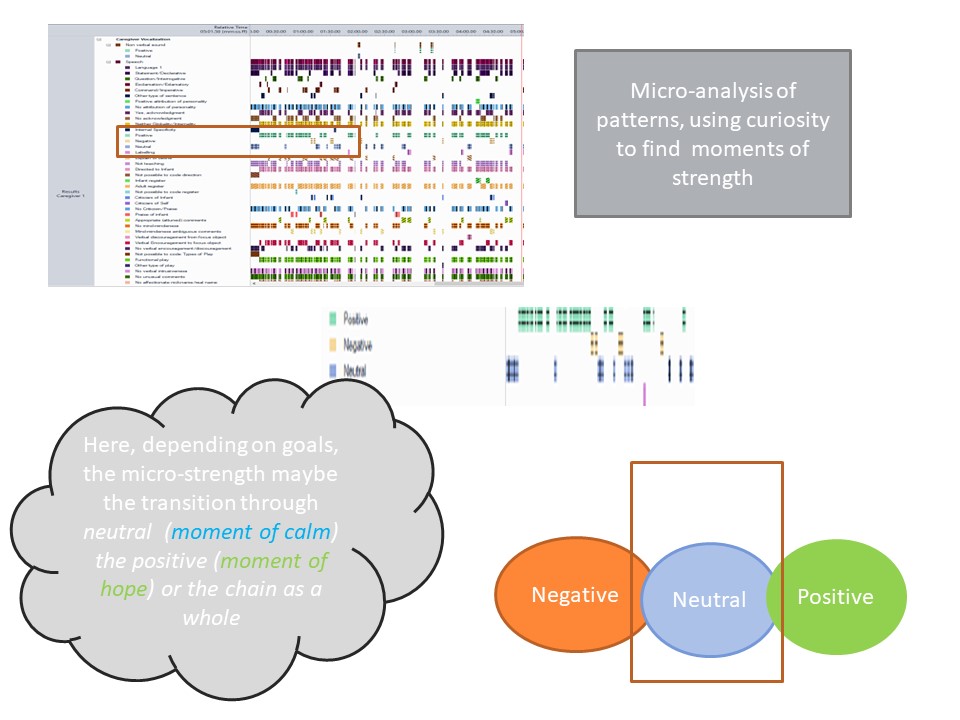Micro strengths: How can we understand and target exceptional moments in relationships, and how can they be drawn on within relationships as a basis for positive change?
In the final stages of the ERC MHINT project we are exploring ‘micro analysis’ of videos of parents and babies interacting with each other. We are also trying to understand where they exhibit micro strengths and how that relates to methods such as video feedback. The idea is that once we find ‘mirco-strengths’ individuals watch back the moment that they give off a micro strength to better understand this phenomenon.
What are micro strengths?
A micro strength can be thought of as a moment that stands out within an interaction. It is more than the obvious moments of a shared smile or hug. It may be a moment where you experience a sense of understanding with another person, for example, a shared moment of calm or intuitively knowing that the other person is sad.
Micro strengths are the idea that everything can be broken down into the smallest components, specific moments – a single moment in time, a microsecond. What our brains are doing at this micro-moment is highly sophisticated. Our brains are computed to monitor micro-moments of interaction. In simple terms, some of us can notice body language by looking at each other, but it can be affected by many things.
In romantic relationships, micro strengths might be a nice feeling people experience together, a feeling of coming together. Watching back videos and extracting micro strengths is a tool to find that reference point of when interactions went well and allow individuals to trace back shared feelings to that micro-moment.
What is micro analysis?
Microanalysis is the study of these micro strengths. A trained practitioner would be able to notice these unique relational strengths through the microanalysis of verbal and non-verbal behaviour.
Their higher level of skill brings these micro-strengths into awareness and as a basis for self-determined positive change in relationships.

In what kind of scenarios might we experience micro strengths?
We are considering lots of different scenarios. As eating disorders have been on the rise following the pandemic, we’ve put in an application to study these.
Combining this with our public engagement work where trust was a key component important to relationships, a moment of trust would be when someone with an eating disorder eats the food provided.
Trust and understanding are key there.
With these slightly abstract concepts like trust and understanding, we have been wondering how you can break them down into moments.
How do micro strengths help us learn?
Strengths-based video feedback (VF) is a well-known parenting intervention which focuses on developing family relationships. Short segments of recordings of parent-child interactions are shown back to parents/children by a trained practitioner.
For VF to be utilised in more situations and on a larger scale, there is a need for the further understanding of how and knowing what moments are best to choose.
Micro-moments in families: parents and their kids
For this aspect of video feedback, we used two key components: Linking to the particular goals of a person and what moment is ‘exceptional’.
Goals refer to what the individual or family see as important in positive change, or can be an assigned clinical need, sometimes set out by professionals. Exceptional, in other words, is a moment that goes above and beyond the general sequence or pattern.
In the clips provided, there is an exceptionally positive example of building awareness and confidence. However, moments of strength can also provide a base from which the parent and child can talk about what they see as the difficulties of the relationship. Through the experience of VF with families, we have noted that swift, self-determined change arises through their reflection and articulation of what change is needed. This is important because in specialist services and in the community, families’ own learning can easily be overshadowed by the ’expert’ voice.
Psychological traits that influence goals
There may also be known psychological traits and states that guide the goals or targets of micro-strengths. For example, when working with parents, we can draw upon what we know about common symptoms such as depression and anxiety.
Through a lens of anxiety, a parent will interpret emotional information as more threatening, distressing and urgent. They may react quicker and more emotionally. In our early years of micro-analytic work, we found that parental anxiety is associated with a lower frequency of a neutral tone. VF can highlight the moment of calm, sitting back and pausing allowing emotional transitions through neutral (see figure 1).
Through the lens of depression, a parent feels helpless and may withdraw from the interaction when their child doesn’t respond. VF can show them hope (a smile or look from their child/adolescent).
We also know from our previous work that understanding and trust are keys to relationships (see here). Moments which may not be obvious strengths, such as smiles or hugs, may represent key moments of trust and understanding or even in a moment which a parent senses something isn’t right.
Contributors: Professor Deborah James, Dr Alessandra Prioreschi

This work is licensed under Creative Commons Attribution-NonCommercial-NoDerivatives 4.0 International.


